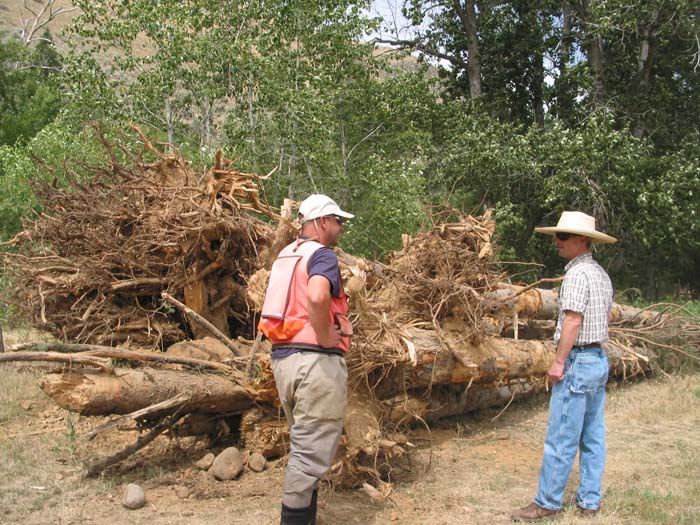Electrofishing operation gets underway in Catherine Creek
Published 7:30 am Tuesday, July 12, 2016

- Aaron Bleisner, left, of the Union Soil and Water Conservation District, and Winston Morton, of the Oregon Department of Fish and Wildlife, examine large trees that will be placed in Catherine Creek to improve its fish habitat. (Dick Mason/The Observer)
UNION — Catherine Creek is in the midst of an electrifying month.
An electrofishing operation to protect fish in Catherine Creek is underway as major habitat restoration work is conducted.
Crews are using backpack electrofishers that generate mild electrical currents that pass through specially made poles placed in water.
The current briefly stuns fish, allowing them to be easily netted. The fish are then transported to another part of Catherine Creek, far from where the habitat restoration work, which involves the use of heavy equipment, that could harm them.
Electrofishing work started July 1 and will continue for about another three weeks.
“We have moved thousands of fish,” said Ian Wilson, of the Confederated Tribes of the Umatilla Indian Reservation, who is responsible for recording the number of fish netted and their species.
Most of the fish moved have been young Chinook salmon and steelhead, sculpin and dace. All are being transported in an ODFW fish liberation truck.
Much of the work is being done by staff from the Confederated Tribes of the Umatilla Indian Reservation, the Oregon Department of Fish and Wildlife and Union Soil and Water Conservation District.
Matt Saladin, of the ODFW, said the work can be tiring but it is also interesting.
“You learn the nuances of how fish react and behave,” Saladin said.
Electrofishing is done only when the water temperature is at or below 64 degrees, said Aaron Bleisner of the Union Soil and Water Conservation District.
Bleisner added that electrofishing is not done when the water is too cloudy to see the fish clearly.
“When it is real turbid, we wait until it clears up,” Bleisner said.
The power of the electrical current emitted by the electroshockers being used is mild at best to someone exposed to it.
“It is a little jolt. Not as bad as touching an electric fence,” Saladin said.
Fish are being collected and transported from areas where natural woody debris, like large, dead trees, is to be placed in the stream channel. The woody debris creates pools, hiding cover and other features that fish like, Bleisner said.
The habitat restoration work, which is being funded by the Bonneville Power Administration and the Oregon Watershed Enhancement Board, involves a stretch of Catherine Creek that begins about three miles east of Union and runs four miles east past this point.
Planning for the project started in 2011, and work began in 2013. A portion of the project has involved restoring the natural meander of Catherine Creek over a stretch of about three-quarters of a mile. This will reduce erosion by slowing Catherine Creek’s flow rate, allowing for a greater diversity of plant life to grow along its banks.
The added plant life will provide additional shade, which will cool the water. Cool water is a critical part of salmon habitat, for they need streams cooler than 64 degrees to survive, said Jesse Steele, of the Grande Ronde Model Watershed.
Catherine Creek lost its natural meander many decades ago when its channel was straightened.
The current habitat restoration project is expected to be finished by the end of the year. The partners who have worked together on the project include the ODFW, the Union Soil and Water Conservation District, the Grande Ronde Model Watershed and the Confederated Tribes of the Umatilla Indian Reservation. Planning and design work was done by the Bureau of Reclamation.
The habitat restoration work is being done with the cooperation of six landowners along the four-mile stretch of Catherine Creek.
Steele said that the landowners’ help has been critical to the success of the project.
“We would have hardly gotten any of this work done without landowner cooperation,” Steele said.
Contact Dick Mason at 541-786-5386 or dmason@lagrandeobserver.com. Follow Dick on Twitter @lgoMason.





